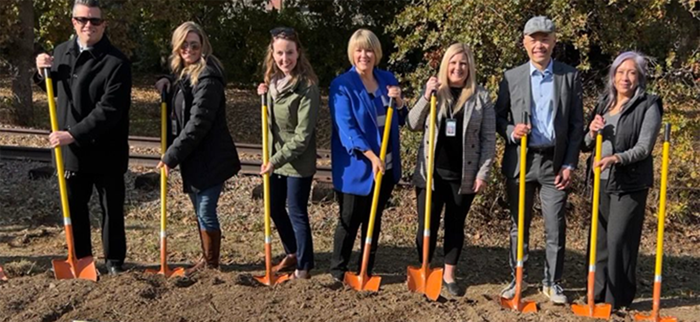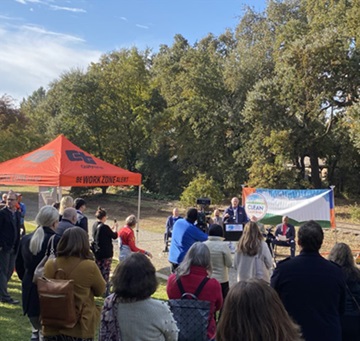Clean California gives local agencies a beautification boost

District 3 photograph
In its first cycle, the Clean California Local Grant Program awarded about $300 million statewide
The Clean California initiative is a multifaceted push to improve not just aesthetics but also the lives of those who reside in or visit the 58 counties within our Golden State.
One of the initiative’s vital components is the Clean California Local Grant Program (CCLGP) managed by Caltrans Division of Local Assistance. The program, which in its first cycle last year awarded approximately $300 million to 105 local agencies, is helping communities beautify and improve streets, tribal lands, parks, pathways and transit centers.
Cycle 2 of the program, which will provide approximately $100 million in grant funding to local communities, accepted applications through April.
The program’s four goals are:
- Reduce the amount of waste and debris within public rights-of-way, pathways, parks, transit centers, and other public spaces.
- Enhance, rehabilitate, restore, or install measures to beautify and improve public spaces and mitigate the urban heat island effect.
- Enhance public health, cultural connection, and community placemaking by improving public spaces for walking and recreation.
- Advance equity for underserved communities.
Caltrans lists and briefly describes the Cycle 1 grant recipients online. Local projects were provided grant awards, ranging in size from the maximum $5 million all the way down to several whose total project cost is less than $1 million. There is no minimum grant amount request for this program.
One example is the Hoopa Four Project, whose entire $5 million cost is covered by a Clean California grant. The District 1 project will provide debris removal, beautification, rehabilitation and enhancement to community parks and spaces for ADA accessibility for rolling, walking and recreation. Pookey’s Park, Hoopa Rodeo Grounds, Tish-Tang Campground and Neighborhood Facilities are among the sites scheduled for improvements.

The Del Rio Trail through an inner-city neighborhood promises to benefit bicyclists, runners, dog-walkers and other outdoor enthusiasts.
District 3 photograph
Pookey’s Park, opened in 1977, encompasses 11.5 acres and serves as a quasi-extension of school playgrounds and is regularly utilized by nearby schools. The Rodeo Grounds and TishTang Campground are similarly sized and in need of modernization. The Neighborhood Facilities is a 6.2-acre parcel of lands encompassing the Hoopa tribal administrative and recreation departments.
This small but transformative project will increase the availability of public spaces to the underserved community of the North State town.
Also among the $5 million grantees was the city of Sacramento, for its $16.7 million Del Rio Trail project. The proposed 4.8-mile trail will run south through the Land Park, South Land Park, Freeport Manor, Z’Berg, Pocket, and Meadowview neighborhoods between Interstate 5 and Freeport Boulevard.
A Sacramento city webpage describes the project as "an inner-city trail that will allow cyclists, pedestrians, runners, and dog walkers to travel for miles to access schools, parks, retail centers, and jobs. It provides the potential for recreation amenities and will serve as an alternative commute route for people to bike to work rather than drive on freeways and boulevards.”
The project will contain 10 public art works and plant some 810 trees. A groundbreaking ceremony was conducted last autumn and a short video summary of the event is posted on YouTube. From the groundbreaking event, it was clear that the community is excited about this project and its potential to benefit underserved communities, just like the Quincy Pocket Park project.
For Cycle 2 of the CCLGP, Caltrans has refined the project selection criteria to further support:
- Community need
- Potential to enhance and beautify public space
- Potential for greening to provide shade, reduction of the urban heat island effect, and use of native drought-tolerant plants
- Potential to improve access to public space
- Public engagement in the project proposal that reflects community priorities
- Benefit to underserved communities
Awards are to be announced late this summer, and projects are to be completed by June 30, 2026.
Required local match funds are based on the level of disadvantage in the community surrounding the project location(s) and can range from zero to 50 percent of total grant amount request. The required local match will decrease as the disadvantage of the community increases.
Also in Cycle 2, eligible project sites must be partially or fully located in an underserved community, and at least 75 percent of the population surrounding the project site(s) must be underserved.
For more information on the program, including upcoming workshops on how to complete the application, visit this Clean California webpage.
Source: Gretchen Chavez, chief of the Office of Innovative Programs, Division of Local Assistance

